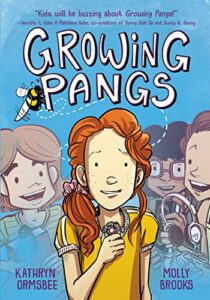 Review By: Liz Geist
Review By: Liz Geist
Published: 2022
Genre(s): YA Graphic Novel, Fiction, Nonfiction Blend
Audience: Grades 6 to 9
Content Warnings: Mental health (OCD)
Goodreads Link: Growing Pangs
Publisher’s Summary:
New grade. New friends. New worries? Introducing a graphic novel about friendship, anxiety, and growing up!
Katie knows there’s stuff that makes her different. She’s homeschooled, she has freckles, and her teeth are really crooked. But none of these things matter to Kacey. They’re best friends forever–just like their necklaces say. But when they go to summer camp, Kacey starts acting weird. What happened to the “forever”? And when Katie gets home, she can’t stop worrying. About getting braces. About 6th grade. About friends. She knows tapping three times or opening and closing a drawer won’t make everything better . . . but sometimes it helps stop the worrying. Is something wrong with her? And will anyone want to be friends with her if they find out?
Review:
Growing Pangs by Kathryn Ormsbee and illustrated by Molly Brooks is a heartfelt, relatable graphic novel that thoughtfully explores mental health, friendship, and the challenges of growing up. The book follows Katie, a homeschooled young teen, as she navigates friendships, summer camp drama, and the development of anxiety, visualized as a buzzing bee that appears when she feels stressed or overwhelmed. The story begins with Katie and her best friend Kacey at camp, where Katie branches out and meets new people. Kacey becomes jealous, and when they return home, their friendship continues to drift.
As Katie enjoys new friendships and takes on a role in a local play, her anxiety intensifies. The buzzing bees multiply, representing intrusive thoughts and compulsive behaviors, such as tapping or touching objects to prevent bad things from happening. Eventually, Katie opens up to her parents, learning that her dad experienced similar feelings as a child—his depicted as a cricket. With their support, she begins therapy and takes her first steps toward understanding and managing her OCD.
The reviewer enjoyed the book and appreciated how it normalizes the many ways teens and adults experience anxiety and OCD. The illustrations convey these feelings effectively, making the book an excellent tool for mental health conversations. As a health teacher, the reviewer notes that this title would work well for group reading or classroom discussion. It is especially valuable for young teens who may be questioning whether their thoughts or feelings are “normal.”



